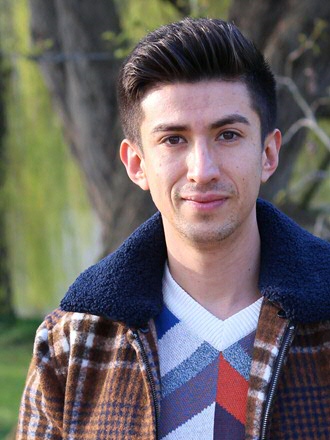NEVAC prize for Brian Baker of the Stöhr group

Brian Baker, PhD student in the group of Prof. Meike Stöhr is the 2020 winner of the NEVAC (Nederlandse Vacüumvereniging) prize. The prize is awarded annually for the best article for the NEVAC journal written by students or PhD students. The winner receives 1000 Euro for an article on unique research where the use of vacuum technology is explained. Brian Baker received the prize for his article on "Coverage-Dependent Metal-Organic Coordination Networks on Au(111)". Below you find a summary of the awarded article.
Coverage-Dependent Metal-Organic Coordination Networks on Au(111).
Brian David Baker Cortés1, Nico Schmidt2, Mihaela Enache3, Meike Stöhr4
1, 2, 3, 4 Zernike Institute for Advanced Materials, University of Groningen, Nijenborgh 4, 9747 AG Groningen, The Netherlands.
The usage of scanning tunneling microscopy (STM) under ultrahigh-vacuum (UHV) conditions has allowed the scientific community to access real-space imaging of surfaces with atomic resolution. The study of the self-assembly of organic molecules on coinage metal surfaces by means of STM is a well-known topic in the field of surface science – owing to their promising applications in catalysis and gas storage. These two-dimensional (2D) one-atom thick nanostructures can be fabricated by the deposition of organic molecules – such as porphyrins – onto metallic substrates under UHV conditions. In addition, metal-atoms can be incorporated into the organic matrix to mimic three-dimensional (3D) metal-organic frameworks on a surface, that is 2D metal-organic coordination networks (MOCNs). The formation of structurally different MOCNs has been realized on a variety of metal surfaces. However, the influence of molecular coverage (number of molecules on the surface) steering the formation of different metal-ligand coordination motifs on a surface has been rarely addressed. In this article, we report on the influence of molecular coverage in the formation of two structurally different MOCNs supported on Au(111) by means of STM under UHV, and we illustrate the step-by-step process for their fabrication under UHV.1,2 The deposition of a submonolayer of a cyanophenyl-substituted porphyrin derivative on Au(111) at room-temperature gave rise to the formation of a close-packed H-bonded network. However, the subsequent deposition of Co-atoms onto the 2D organic network lead to the formation and coexistence of two structurally different Co-coordinated MOCNs as measured by STM: (i) a four-fold and (ii) a three-fold MOCN, respectively. The four-fold MOCN was observed as the majority phase with respect to the three-fold MOCN. However, by increasing the molecular coverage to a full monolayer, the intrinsic in-plane compression pressure exerted by the molecules on the surface, prompted the formation of the four-fold MOCN as one exclusive phase. Our work demonstrates an alternative route toward the fabrication of structurally different MOCNs on surfaces.
(1) Baker Cortés, B. D.; Schmidt, N.; Enache, M.; Stöhr, M. Coverage-Dependent Structural Transformation of Cyano-Functionalized Porphyrin Networks on Au(111) via Addition of Cobalt Atoms. J. Phys. Chem C 2019, 123, 19681-19687.
More news
-
15 September 2025
Successful visit to the UG by Rector of Institut Teknologi Bandung
